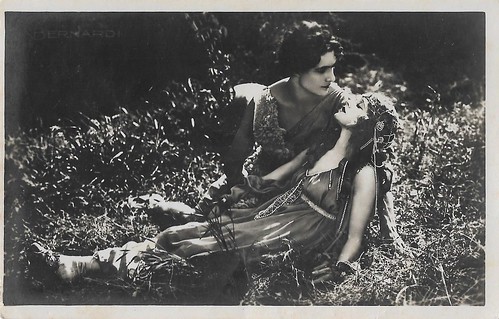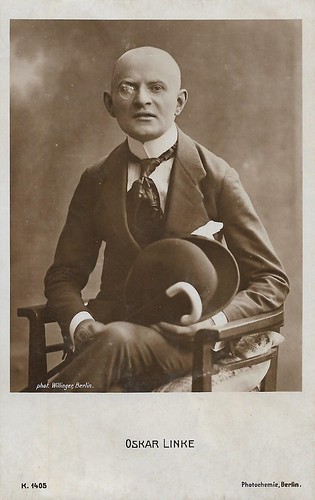
Italian postcard by Ed. Vettori, Bologna. Photo: Fox. Nerio Bernardi as David in The Shepherd King (J. Gordon Edwards, 1923). The woman could be Edy Darclea or Violet Mersereau.
Handsome Nerio Bernardi (1889–1971) was an Italian stage and screen actor and voice actor. In his long career, he acted in some 210 films.

Italian postcard by Ed. Vettori, Bologna, no. 2008. Maria Carmi and Ettore Piergiovanni, together in Forse che sì forse che no (Gaston Ravel, 1921), an adaptation of the novel by Gabriele D'Annunzio. This was the only film in which the two actors acted together. See also this card.
With her aristocratic air, her severe looks but also her sweet undertones, Italian silent film star and stage actress Maria Carmi (1880-1957) was the cinematic translation of the 19th-century Primadonna in Italian and German silent films of the 1910s and early 1920s. She also had an international stage hit with the play 'The Miracle/Das Mirakel'.

Italian postcard by Fotocelere, Torino, no. 142.
Anna Fougez (1894-1966) was a vaudeville star who shone on the Italian stage from the First World War to the mid-1920s. She also played in various Italian films.

Italian postcard by A. Traldi, Milano, no 490. Photo: Fontana.
Liliana De Liguoro is known to have made just one film, Il racconto di carnevale (Max Galotti, Ambra Film/UCI,1921), one of many films produced and scripted by Lucio D'Ambra, directed by one of his collaborators. De Liguoro looks like the spitting image of the better-known Rina De Liguoro, so she may have been a sister, a lookalike, or just Rina herself.

German postcard by Photochemie, Berlin, no. K. 1405. Photo: Willinger, Berlin.
Oskar Linke (?-?) was a German actor and film producer. From 1916 until the early 1920s he had a prolific career in German silent cinema, first as an actor, then as a producer.

French postcard by Europe, no. 188. Photo: Film Aubert. Huguette Duflos and Léon Mathot in the French silent film drama Yasmina (André Hugon, 1927).
Actress Huguette Duflos (1887-1982) was a leading lady in the French silent cinema of the 1920s. French actor and director Léon Mathot (1886-1968\0 became well-known for his role as Edmond Dantès in the French serial Le Comte de Monte-Cristo (1918), directed by Henri Pouctal. Mathot became one of the most popular stars of French silent film of the 1920s with such film as L'Empereur des pauvres (René Leprince, 1922) and Coeur fidèle (1923) by Jean Epstein. From 1927, he also became a film director, directing over 20 films.

Italian postcard by G.B. Falci, Milano, no. 352. Photo: Fotolux / Palermi Films. Maria Corda in L'uomo più allegro di Vienna (Amleto Palermi, 1925). We will also create a special post on this film, thanks to several cards we bought in Bologna.
Hungarian Maria Corda (1898-1975) was an immensely popular star of the silent cinema of Austria and Germany. The pretty, blonde actress was a queen of the popular epic spectacles of the 1920s, which were often directed by her husband, Alexander Korda.

Italian postcard by Ed. Traldi, Milano, no. 996. Photo: Ed. Superfilm, S.A., Roma. Actually, these are probably NOT the Dolly Sisters. In this clip you can see many female dancers in the same outfit and headgear, from ca. 01:50: YouTube. So the girls on this card may be two of the Tiller's Follies Girls or the Hoffman Girls, who did perform in this revue.
Rosie Dolly (1892-1970) and Jenny Dolly (1892-1941), known professionally as The Dolly Sisters, were Hungarian-American identical twin dancers, singers and actresses, popular in vaudeville and theatre during the 1910s and 1920s. Both sisters also appeared in two silent films.

Romanian postcard. Photo: MGM. Marion Davies and Antonio Moreno in Beverly of Graustark (Sidney Franklin, 1926). The film was one of the highlights at the Giornate del Cinema Muto in Pordenone in 2019. See the blogpost of ithankyouarthur on the film.
Marion Davies (1897-1961) was one of the great comedic actresses of the silent era. She starred in nearly four dozen films between 1917 and 1937. Antonio 'Tony' Moreno (1887-1967) was a Spanish-born American actor and film director of the silent film era and through the 1950s. In his early films, Moreno was often typecast as the 'Latin Lover'. He is best known for films such as The Spanish Dancer (1923) with Pola Negri, Mare Nostrum (1926) with Alice Terry, The Temptress (1926) with Greta Garbo, and It (1927) with Clara Bow.

Italian postcard, No. 63. Photo: Artisti Associati (United Artists). Vilma Banky and Ronald Colman in Feudalismo, the Italian release title for The Night of Love (Samuel Goldwyn, 1927).
Hungarian-born silent film star Vilma Bánky (1901-1991) was filmed in Budapest, France, Austria, and Germany before Sam Goldwyn took her to Hollywood. There she starred opposite silent stars like Rudolph Valentino and Ronald Colman. She became Goldwyn's biggest moneymaker till sound finished her career. English gentleman-actor Ronald Colman (1891-1958) was a top box office draw in Hollywood films throughout the 1920s, 1930s, and 1940s. ‘The man with the velvet voice’ was nominated for four Academy Awards. In 1948 he finally won the Oscar for his splendid portrayal of a tormented actor in A Double Life.

Italian postcard by G.B. Falci, Milano, no. 8. Photo: production Cines-Pittaluga. Elio Steiner in L'uomo dall'artiglio/The Man with the Claw (Nunzio Malasomma, 1931). The man on the right could be Vasco Creti as the commissioner. The film is considered a precursor of the Giallo genre. The leads were for Dria Paolo and Carlo Fontana. The plot deals with a series of violent murders carried out by an escaped criminal, armed with a strange claw. When he murders the engineer of a brand new racing car, one of the drivers (Carlo Fontana) takes the investigation into his own hands.
Elio Steiner (1905–1965) was an Italian stage and screen actor, who peaked in the early 1930s in films such as La canzone dell'amore, Corte d'Assise and Pergolesi.

Italian postcard by Rizzoli, 1934. Photo: Novella Film. Franco Coop as the impressario in La signora di tutti (Max Ophüls, 1934), starring Isa Miranda. See our blog post at European Film Star Postcards.
Franco Coop (1891-1962) was a highly prolific actor in Italian sound cinema from the early 1930s onward.

Italian postcard by Tirrenia Cinematografica. Photo: Pisorno Studios. Scene from the Italian historical film Sei bambine e il Perseo (Giovacchino Forzano, 1940), on the life of the artist Benvenuto Cellini, with Augusto Di Giovanni in the title role, as father of six girls but also the creator of the Perseus statue in the Loggia dei Lanzi in Florence. In Germany, the film was released as Flammen in Florenz. See also another card for this film: www.flickr.com/photos/truusbobjantoo/50528513833/in/photo.... The fresco in the back is a copy of the original one on 'The Triumph of Furio Camillo' (1545) by Francesco Salviati, at the Palazzo Vecchio in Florence.

Italian postcard. Photo: Venturini.
Vera Bergman (1920–1971) was the daughter of a German diplomat and became a star in Italian films in the 1940s.
No comments:
Post a Comment